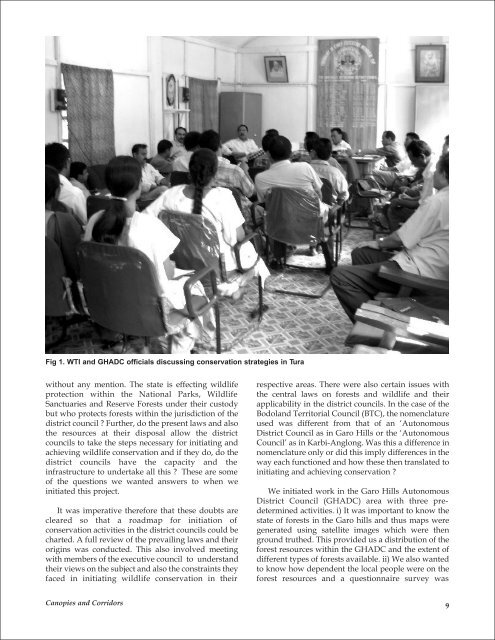Canopies and Corridors - International Fund for Animal Welfare
Canopies and Corridors - International Fund for Animal Welfare
Canopies and Corridors - International Fund for Animal Welfare
You also want an ePaper? Increase the reach of your titles
YUMPU automatically turns print PDFs into web optimized ePapers that Google loves.
Fig 1. WTI <strong>and</strong> GHADC officials discussing conservation strategies in Tura<br />
without any mention. The state is effecting wildlife<br />
protection within the National Parks, Wildlife<br />
Sanctuaries <strong>and</strong> Reserve Forests under their custody<br />
but who protects <strong>for</strong>ests within the jurisdiction of the<br />
district council ? Further, do the present laws <strong>and</strong> also<br />
the resources at their disposal allow the district<br />
councils to take the steps necessary <strong>for</strong> initiating <strong>and</strong><br />
achieving wildlife conservation <strong>and</strong> if they do, do the<br />
district councils have the capacity <strong>and</strong> the<br />
infrastructure to undertake all this ? These are some<br />
of the questions we wanted answers to when we<br />
initiated this project.<br />
It was imperative there<strong>for</strong>e that these doubts are<br />
cleared so that a roadmap <strong>for</strong> initiation of<br />
conservation activities in the district councils could be<br />
charted. A full review of the prevailing laws <strong>and</strong> their<br />
origins was conducted. This also involved meeting<br />
with members of the executive council to underst<strong>and</strong><br />
their views on the subject <strong>and</strong> also the constraints they<br />
faced in initiating wildlife conservation in their<br />
<strong>Canopies</strong> <strong>and</strong> <strong>Corridors</strong><br />
respective areas. There were also certain issues with<br />
the central laws on <strong>for</strong>ests <strong>and</strong> wildlife <strong>and</strong> their<br />
applicability in the district councils. In the case of the<br />
Bodol<strong>and</strong> Territorial Council (BTC), the nomenclature<br />
used was different from that of an ‘Autonomous<br />
District Council as in Garo Hills or the ‘Autonomous<br />
Council’ as in Karbi-Anglong. Was this a difference in<br />
nomenclature only or did this imply differences in the<br />
way each functioned <strong>and</strong> how these then translated to<br />
initiating <strong>and</strong> achieving conservation ?<br />
We initiated work in the Garo Hills Autonomous<br />
District Council (GHADC) area with three predetermined<br />
activities. i) It was important to know the<br />
state of <strong>for</strong>ests in the Garo hills <strong>and</strong> thus maps were<br />
generated using satellite images which were then<br />
ground truthed. This provided us a distribution of the<br />
<strong>for</strong>est resources within the GHADC <strong>and</strong> the extent of<br />
different types of <strong>for</strong>ests available. ii) We also wanted<br />
to know how dependent the local people were on the<br />
<strong>for</strong>est resources <strong>and</strong> a questionnaire survey was<br />
9

















